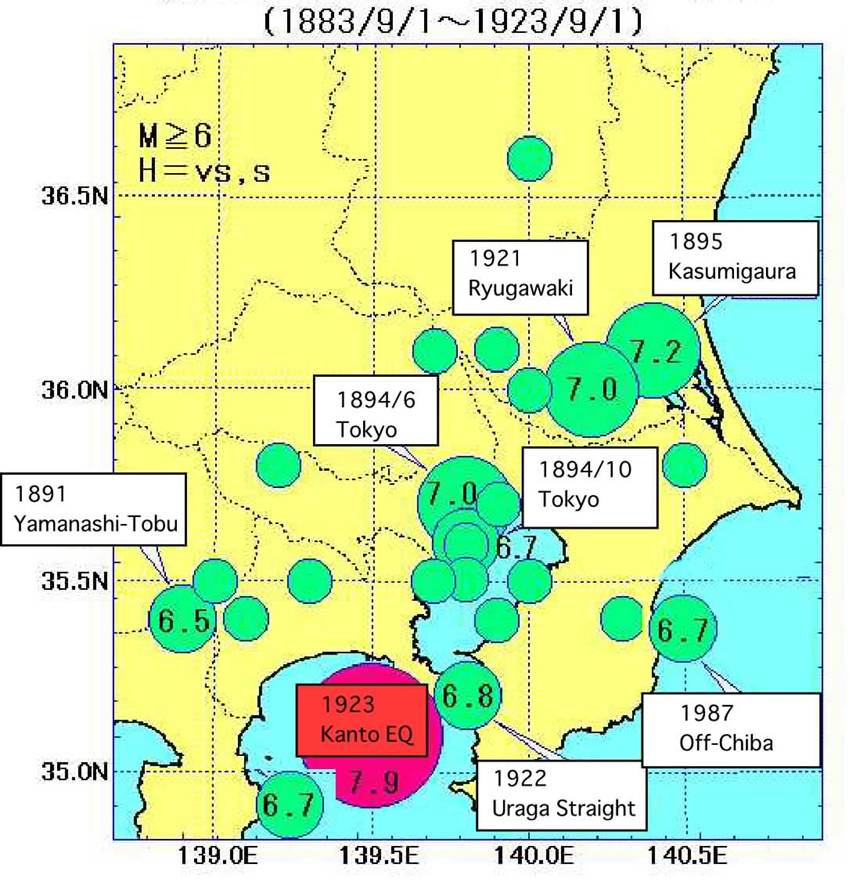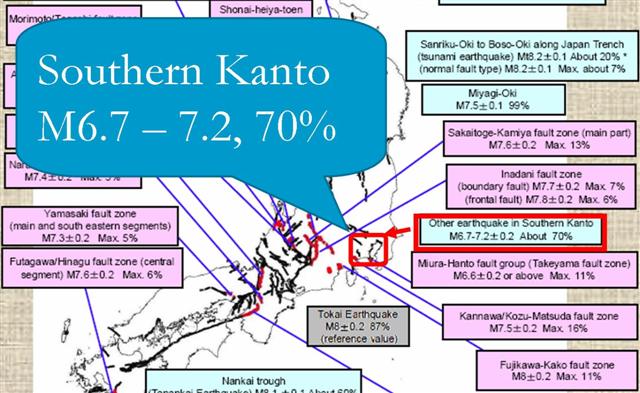Special Project for
Earthquake Disaster Mitigation
in Tokyo Metropolitan Area
Metropolitan Tokyo

 In central Japan, the Philippine Sea plate (PSP) subducts beneath the Tokyo Metropolitan area, the Kanto region, where it causes mega-thrust earthquakes, such as the 1703 Genroku earthquake (M 8.0) and the 1923 Kanto earthquake (M 7.9) which had 105,000 fatalities. The vertical proximity of this down going lithospheric plate is of concern because the greater Tokyo urban region has a population of 42 million and is the center of approximately 40 % of the nation's activities.
In central Japan, the Philippine Sea plate (PSP) subducts beneath the Tokyo Metropolitan area, the Kanto region, where it causes mega-thrust earthquakes, such as the 1703 Genroku earthquake (M 8.0) and the 1923 Kanto earthquake (M 7.9) which had 105,000 fatalities. The vertical proximity of this down going lithospheric plate is of concern because the greater Tokyo urban region has a population of 42 million and is the center of approximately 40 % of the nation's activities.
A M 7 or greater (M 7+) earthquake in this region at present has high potential to produce devastating loss of life and property with even greater global economic repercussions. The Central Disaster Management Council of Japan estimates the next great earthquake will cause 11,000 fatalities and 112 trillion yen (1 trillion US$) economic loss. This great earthquake is evaluated to occur with a probability of 70 % in 30 years by the Earthquake Research Committee of Japan.
Special Projects in Metropolitan area
We conducted the Special Project for Earthquake Disaster Mitigation in Urban Areas (2002-2006). This project revealed the detailed geometry of the subducted PSP and improved information needed for seismic hazards analyses of the largest urban centers.
We have just started the Special Project for Earthquake Disaster Mitigation in Tokyo Metropolitan area (2007-2011).
Regional Characterization
Assessment in Kanto of the seismic hazards produced by the PSP mega-thrust earthquakes requires identifications of all significant faults, possible earthquake scenarios, rupture behaviors, regional characterizations of PSP geometry, the physical properties of overlying Honshu arc (e.g. seismic wave velocities, densities, attenuation), and local near-surface seismic site effects.
Results so far obtained
Our study addresses
- improved regional characterization of the PSP geometry based on
- new deep seismic profiles (Sato et al., 2005),
- reprocessed off-shore profiles (Kimura et al., 2006) and
- a dense seismic array in the Boso peninsular (Hagiwara et al., 2006), and
- identification of asperities of the mega-thrust at the top of PSP.
We qualitatively examine the relationship between seismic reflections and asperities inferred by reflection physical properties.
We also discuss the relation between a deformation of PSP and intra-slab M 7+ earthquakes: the PSP is subducting beneath the Honshu arc and also colliding with the Pacific plate. The subduction and collision both contribute active seismicity in the Kanto region. We present a high resolution tomographic image to show low velocity zone which suggests a possible internal failure of the slab; a source region of the M 7+ intra-slab earthquake. Our study contributes a new assessment of the seismic hazard in the Tokyo Metropolitan area.
© Earthquake Research Institute, the University of Tokyo.

 In central Japan, the Philippine Sea plate (PSP) subducts beneath the Tokyo Metropolitan area, the Kanto region, where it causes mega-thrust earthquakes, such as the 1703 Genroku earthquake (M 8.0) and the 1923 Kanto earthquake (M 7.9) which had 105,000 fatalities. The vertical proximity of this down going lithospheric plate is of concern because the greater Tokyo urban region has a population of 42 million and is the center of approximately 40 % of the nation's activities.
In central Japan, the Philippine Sea plate (PSP) subducts beneath the Tokyo Metropolitan area, the Kanto region, where it causes mega-thrust earthquakes, such as the 1703 Genroku earthquake (M 8.0) and the 1923 Kanto earthquake (M 7.9) which had 105,000 fatalities. The vertical proximity of this down going lithospheric plate is of concern because the greater Tokyo urban region has a population of 42 million and is the center of approximately 40 % of the nation's activities.